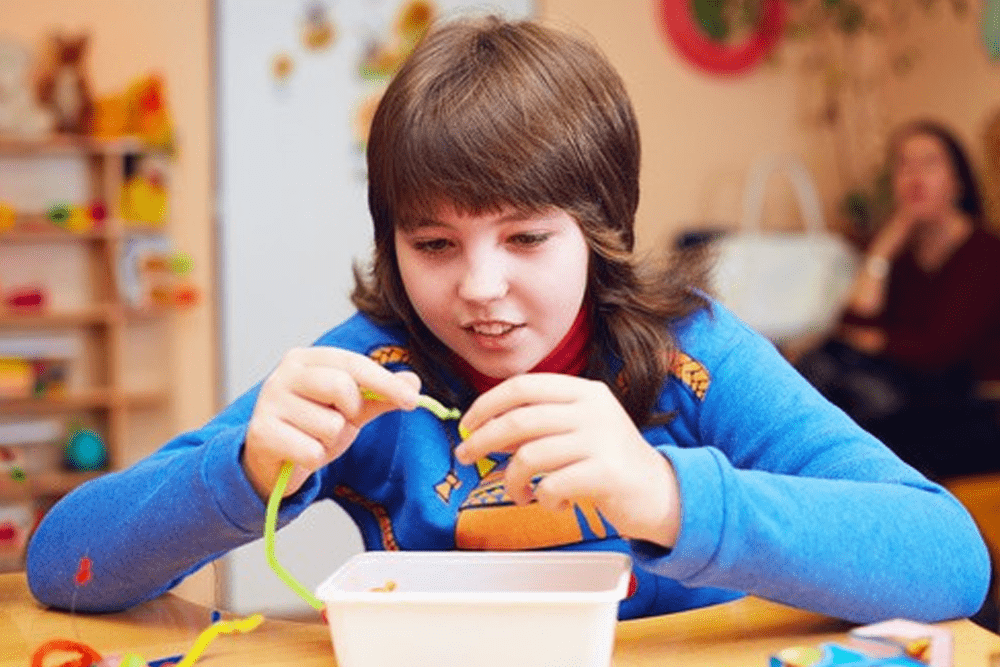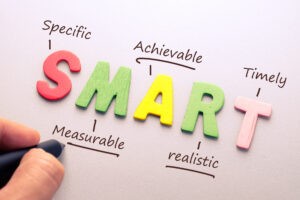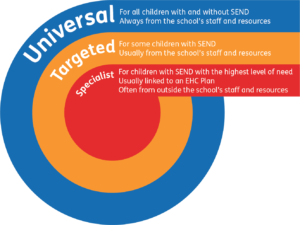They crop up in meetings and in conversations with professionals and you’ll see them written on your child’s paperwork and plans too.
These five terms are key to understanding the support your child gets and how it’s going to work.
Most of these terms are in school plans and Educational Health and Care (EHC) plans. So it’s important for you to know what they mean. You can find out more about schools plans in the section of the website about SEN support.

Every child or young person with SEND should have a written plan of some kind. This could be a plan that is made and used by nursery, school or college staff or an Education Health and Care (EHC) plan. Schools and colleges use all kinds of plans, so your child’s plan may look different from one for a child from a different school.
Whatever type of plan it is, it’s important that it’s used, kept up-to-date and reviewed regularly. It should change as your child’s needs change.
The foundations of any good plan are your child’s aspirations. That means the plan should start with what your child (and you) want for their future. Once you and the professionals know that, you can work out what their needs are, how they are going to achieve their goals and what support they need.
Your child’s plan should explain:
These aspirations, needs, outcomes and provision together make up something called ‘the golden thread’.
The Council for Disabled Children has published two documents about examples of good practice in EHC plans. These include examples of how aspirations, needs, outcomes and provision can be written down so that they are clear and easily understood.
 Aspirations are hopes or ambitions for the future.
Aspirations are hopes or ambitions for the future.
They should be the starting point for SEN support and for all the plans made for a child or young person. Keeping aspirations at the centre of discussions between parents, children and professionals helps to create strong and effective support which makes a real difference.
The most effective support for children and young people with SEND happens when their aspirations are linked to their needs, and then to outcomes and support (provision). This forms The Golden Thread – you can find out more about that below.
When your child is very young, you’ll have hopes and dreams for what you’d like them to achieve. As their parent, you’ll be the one with the aspirations.
As your child grows older, they will start to have and share their own aspirations. These might be about what they want to be when they grow up, what’s important in their lives and what they want to achieve.
As your young person grows towards adulthood, their aspirations will probably focus more on becoming as independent as they can be. They might be about the work they would like to do, and on their hopes and dreams for their life as an adult.
The aspirations that children and young people have are often very different from those parents or the professionals may choose. They’re usually broad and focus on whole life (holistic) ambitions, rather than just education. Here are a few examples of the kind of aspirations children and young people have. To
The SEND Code of Practice is the legal guidance for organisations that support children and young people with SEND. It mentions aspirations 47 times! The guidance says that professionals are expected to have, and encourage, high aspirations and expectations for all children and young people with SEND. It also says that ‘support and interventions provided should be selected to meet the student’s aspirations’.
As a parent or carer, you can help your child or young person by doing the following.
Your child’s needs are essentially the things that they have difficulty doing, or find challenging, compared to other children their age.
A child has a special educational need if both these things are true for them:
1. They have a learning difficulty or disability. This means:
or
2. Their learning difficulty or disability means they need educational or training support that is additional to, or different from, that made generally for other children or young people of the same age.
So, in other words, if your child or young person has a learning difficulty or disability and they need extra or different support from others of their age, then they have a special educational need.
Special educational needs affect different children in different ways. For example, your child may find it hard to:
There are four areas of special educational need:
In your child’s school or college plan, or their EHC plan, each of their special educational needs must be included. That means any health or social care needs that affect their education too.
 Here are examples of needs:
Here are examples of needs:
Each special educational need your child has should have an outcome that goes with it.
The outcome should say clearly what your child will be able to do because of the support they will get for that particular need. You might want to think of them as targets or goals for your child to aim for, which help them to reach their longer-term aspirations. Or think of them as like stepping-stones on their journey towards being as independent as they can be.
It’s important when the outcomes for your child are set, that they’re written from your child’s perspective rather than from the professional’s or local authority’s perspective.
Outcomes can be short, medium or long-term. There are two types of outcomes which are often written together:
So, as an example, thinking about a child’s speech and language needs – what is important to them may be that they want to be able to talk to their friends and join in their games at playtime. What is important for them is that their behaviour improves because they no longer get frustrated at not being understood.
 Outcomes should also be written so that they are ‘SMART’. This means they should be
Outcomes should also be written so that they are ‘SMART’. This means they should be
Here are some examples:
Provision is another word for support.
It’s the things that the nursery, school or college do or provide that help your child to achieve and make progress. This is support that is different from, or extra to, what other children in their age group are getting.
If your child’s nursery, school or college is giving them support for a special educational need, they must tell you. That support should be written in your child’s plan and set out so that it’s clear what need it’s meeting.
In your child’s plan, the support they are getting should be written so that it is:
SEN support in nurseries, schools and colleges is based around the specific needs of each child or young person. The staff, equipment, resources and support that help your child are decided using something called the graduated approach. This is an ‘assess, plan, do, and review’ cycle.
That means if your child has special educational needs, the school or college should:
 The support your child gets will depend on their individual needs. There are three types of support – universal, targeted and specialist.
The support your child gets will depend on their individual needs. There are three types of support – universal, targeted and specialist.
Universal provision
This is support that is given in all schools, in every classroom, by every teacher and for all children. The funding for it and the expertise to do it all come from the schools resources.
It’s focused around differentiated learning. That means the level at which your child is learning may be different to that of other children in their class, so work is changed to meet their needs. Teachers do this routinely for every lesson
Targeted Provision
This is support that can be given in all schools, in every classroom, by every teacher, and for some children. It’s extra to, or different from, universal provision. There is funding and expertise in school for most of the children who need targeted support. A child will have a school-based plan which sets out this kind of support. The staff at school may also need to get professional advice for some areas of support.
Specialist Provision
This is support that’s available in all schools and some classrooms, but for very few children. The funding and expertise may need to come from outside the school’s resources. If your child needs specialist provision, school staff will usually need to get specialist advice. This kind of support is usually given to children and young people with long term complex needs and/or disabilities, often with an EHC plan. It’s the type of support often given in special schools, though it’s also given in mainstream schools.
If you want to find out more about what kind of support is possible and available, have a look at Devon’s ordinarily available inclusive provision website for schools and settings. Like every county in England, Devon also has a Local Offer. That sets out what you can expect to be available to support children with SEND in Devon.
Your aspirations and your child’s should be the starting point for discussions about support. Once you know what your child’s aspirations are, you can link those to the things they need in school or college and the support that will help them. These are all linked to outcomes too, which are like stepping-stones towards your child’s long-term goals.
All these things together form something called The Golden Thread.
Here is an example of a golden thread for an Education, Health and Care plan. It starts with Sarah’s goal to have more friends and takes a long-term approach to meeting that goal.
Sarah’s school should have a plan they use with some short-term goals as well. For children without EHC plans, the golden thread should also be used to plan and give their support in school or college.
Aspiration: Sarah wants to have friends.
Needs: Sarah has a language delay and it affects her learning and social interaction with other children her age. It is also affecting her confidence and self-esteem which means that she can be socially vulnerable.
Outcome: By the age of 16 Sarah will have a small group of friends and be able to travel independently so she can meet with them. She will meet friends outside home and school and have and use a social network.
Support (provision): Sarah will have travel training which will include buddy support. Sarah will have a mentor who meets her weekly for three hours to explore her interests. Her mentor will help her develop friendship opportunities and support her to take part in social and leisure activities. Sarah will take part in twice weekly social skills group at school with a Teaching Assistant.
Page reviewed: April 2024
Page due for review: April 2026
DiAS (Devon, Information, Advice and Support) supports children and young people aged 0-25 with special educational needs and disabilities (SEND), and their parents and carers.
Helpful links
Contact us
Legal
© 2025 Devon Information Advice & Support
Searching...